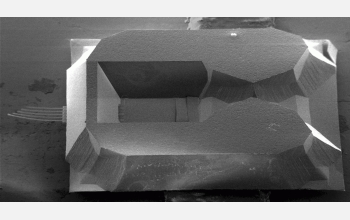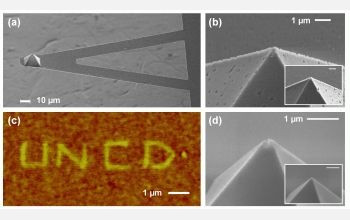All Images
Research News
The World’s Smallest Fountain Pen?

Horacio Espinosa and colleagues at the NSF Nanoscale Science and Engineering Center for Integrated Nanopatterning and Detection Technologies created these two frictional atomic force microscopy images using the new nanofountain probe. The line widths on the letter "N" are as thin as 40 nanometers, and the swatches in the right-side image are less than 10 microns long. The inset on the right-side image shows pattern detail.
Credit: © 2005 Horacio D. Espinosa
Download the high-resolution JPG version of the image. (869 KB)
Use your mouse to right-click (Mac users may need to Ctrl-click) the link above and choose the option that will save the file or target to your computer.

This scanning electron micrograph shows the new nanofountain-probe dispensing tip.
Credit: © 2005 Horacio D. Espinosa
Download the high-resolution JPG version of the image. (261 KB)
Use your mouse to right-click (Mac users may need to Ctrl-click) the link above and choose the option that will save the file or target to your computer.

The scanning electron micrograph shows a nanofountain-probe chip, including cantilevers and the on-chip reservoir.
Credit: © 2005 Horacio D. Espinosa
Download the high-resolution JPG version of the image. (706 KB)
Use your mouse to right-click (Mac users may need to Ctrl-click) the link above and choose the option that will save the file or target to your computer.

This slide highlights the components and features of the nanofountain probe (NFP). (a) The schematic illustrates the NFP writing mechanism. A molecular ink drawn from an on-chip reservoir forms a liquid air interface at the aperture of the volcano-like dispensing tip. Molecules diffuse from the interface to a substrate and capillary condensation forms a water meniscus. (b) This schematic shows how capillary force delivers liquid from the reservoir to the dispensing tip. (c) The scanning electron micrograph shows an NFP dispensing tip. (d) The scanning electron micrograph of the NFP chip shows cantilevers and an on-chip reservoir. (e) The scanning electron micrograph shows an NFP linear array. Insets show blow-ups of a dispensing tip at the end of a cantilever. (f) These are frictional atomic force microscopy images of features patterned by an NFP. Patterns have line widths as thin as 40 nm.
Credit: © 2005 Horacio D. Espinosa
Download the high-resolution JPG version of the image. (3.4 MB)
Use your mouse to right-click (Mac users may need to Ctrl-click) the link above and choose the option that will save the file or target to your computer.

This slide highlights the ultra-nano-crystalline diamond (UNCD) atomic force microscope (AFM) cantilever. (a) This is a scanning-electron micrograph of a UNCD cantilever with a tip. (b) This is a scanning electron micrograph of a UNCD tip after one hour of scanning on a diamond substrate. Inset shows the tip before the scanning. (c) This is a frictional AFM image of an alkanethiol monolayer patterned onto a gold substrate with a UNCD tip. Researchers used the same tip for patterning and imaging. (d) This scanning electron micrograph shows a commercially available silicon nitride tip after one hour of scanning with the same parameters used for the UNCD tip in (b). The image shows damage at the tip apex while the inset shows the tip prior to the test.
Credit: © 2005 Horacio D. Espinosa
Download the high-resolution JPG version of the image. (2.5 MB)
Use your mouse to right-click (Mac users may need to Ctrl-click) the link above and choose the option that will save the file or target to your computer.


